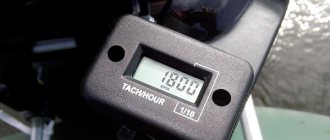What are engine hours
An engine hour is a unit of measurement for the duration of engine operation and its reserve, taking into account all factors, including unstable ones. This parameter cannot be equated to one hour; under certain conditions it is equal to, more or less than a regular hour. When calculating, the operating modes of the unit are taken into account; the crankshaft revolutions are calculated on the tachometer. Since the engine hour does not have an exact concept of time, sometimes it becomes necessary to convert it to the usual astronomical hour, for example, in the case of planning maintenance.
How to write correctly, engine hour or engine hour
If you always write correctly and do not make mistakes in spelling words, you should know that the abbreviation of the concept of “engine hour” is written as “engine hour”, “engine hour” or “motor hour”. Different dictionaries offer different spellings, this is due to the fact that, according to the rule, compound words of all types, to which this term refers, must be written together, but if we consider complex units of measurement, in this case the word already falls under the exception, therefore it is written through hyphen. Linguists have not come to a consensus, and, despite the fact that the continuous spelling is considered outdated, according to the Dictionary of Abbreviations of the Russian Language, as well as the Spelling Dictionary, “motochas” is correct to write. These types of abbreviations are also always written in lowercase letters.
How are engine hours calculated?
The engine hour is a special unit of measurement of the load experienced by a running motor. It corresponds to one astronomical hour of crankshaft operation at idle or moderate speed (60 minutes at about 1500-1600 rpm). This indicator is not equal to mileage or operating time and is relevant primarily for small-capacity vehicles (motorcycles, including cross-country motorcycles), as well as special equipment, the operation of which is not assessed by the distance traveled.
There are different ways to calculate engine hours:
- The most accurate is based on crankshaft revolutions. 1 engine hour is 96,000 crankshaft revolutions (for convenience, you can round up to 100 thousand).
- In terms of time, this is approximately one hour of idling engine operation.
- Based on the fuel used.
The engine hours show the load of the working tractor
Equipment, the amount of work of which is not calculated based on kilometers traveled, is equipped with a special meter that is connected to the spark plugs and reacts to sparks. This is the easiest and most reliable way to count engine hours on tractors, walk-behind tractors and other equipment.
What can you learn from engine hours?
The engine hour indirectly informs the driver about some important points, the timely analysis of which determines the condition of the car. As is clear from the word itself, an engine hour is one hour of engine operation. However, not everything is so simple and we are not talking about linear time. This parameter is important for its influence on a number of indicators, the main of which is mileage and engine life. 1 engine hour is equal to 1 hour of engine operation at rated speed.
The engine hour is not always equal to the astronomical one, and depends on the number of crankshaft revolutions (average speed taking into account idle speed). That is, if the car is idling (for example, in a traffic jam), then the engine hour will be longer. And vice versa, when driving at speeds of 2-3 thousand, the duration of the engine hour will be less than the astronomical hour.
An alternative way to select the correct oil change interval
To calculate, you need to take into account the amount of fuel per 100 km of travel according to the passport and in fact (with a conditional mileage of 15 thousand kilometers). For example, according to the passport it is 8 liters, but in fact it is 10.6 liters. Theoretically, a car spends 1200 liters per 15,000 km (15,000 multiplied by 8 and divided by 100), but in fact – 1,590 liters (15,000 multiplied by 10.6 and divided by 100).
You can calculate it in another way, taking into account knowledge of the fuel consumption rate in the combined cycle (for a specific car) and the frequency of oil changes per kilometer (recommended by the manufacturer). For example, if a car needs about 7 liters of fuel per 100 km, and uses oil with a mileage of 15 thousand km, then this mileage is divided by 7. As soon as the specified amount of fuel is consumed, it is necessary to change the oil.
Now are you convinced why it is so important to count the engine hours of your car? At first it may seem difficult, but then it becomes a habit, and your car will serve you for a long time and will never let you down.
Calculation example
Let's assume that a diesel forklift was rented to load trucks and unload wagons. It works for the entire shift (8 hours), without overcoming slopes and without using the maximum fork lift height, since the sites it serves are located at a height of only 1,500-2,000 mm. The maximum engine speed is only used when the unit is accelerating to cover the distance between the loading and unloading areas. This operation takes approximately 30% of working time.
But it may be so. The company operates 24 hours a day. But shipment of materials (products) during this time is carried out only 2 times for 2 hours. The remaining time the loader is operated with minimal or medium intensity.
Accordingly, the coefficient characterizing the ratio of operating time with load (maximum/minimum) is lower in the second case. Its value can be accurately determined by measuring the time during which the loader overcomes the resistance of the surface (road) and lifts loads of maximum weight. Summing up the indicators, we obtain the operating time during which maximum loads are applied to the unit. And it is this time that needs to be subtracted from the duration of the (total) one shift.
The required coefficient is the ratio of operating time with minimum and maximum load (70% and 30%, respectively). Therefore, if the forklift was used with a maximum load of 30%, then the value of the coefficient is found by dividing 70% by 30% (that is, the value is 2.3).
For example, the well-known AX50 loader model from Komatsu is equipped with a 4D92E power unit. Its power is 33.8 hp. With. In the event that 30% of the entire work shift is operated at maximum speed, then the fuel consumption for 1 engine hour will be: 33.8x202/(1000x0.85x2.3) = 3.49 liters.
How to calculate engine hours
Many people set the goal of calculations, finding out what the engine hour is equal to in order to calculate how much engine potential is enough. This is not easy to implement, and in any case, the obtained indicators will be relative. Methods for calculating engine hours can be different - from manual calculation with recording of engine performance indicators to the use of mechanical or electrical type meters designed for this, which provides more accurate data, allowing you to monitor the degree of wear. Depending on the accounting method, the parameter may or may not be equal to the standard hour. Engine hours are calculated based on rated power revolutions, that is, an engine hour is equal to an hour of operation at rated speed. At idle, wear is less and the engine hour is higher. Under severe operating conditions, the opposite is true, wear increases (for this reason, if you need to change oils and other consumables, you should not wait for the period recommended by the manufacturer). So, in order to more accurately calculate what one hour of engine operation is equal to, at lower speeds the parameter is calculated by a downward coefficient. Adjustments can also be made to the calculations according to hourly fuel consumption, but clear values cannot be derived.
It is easier to keep track of engine hours for units operating stationary at a stable crankshaft rotation speed with a minimum of errors. For example, this is how diesel generators work, producing electric current with standardized parameters and frequency. In such cases, you can use a manual counting system, keeping records of the time worked by the motor, or use a counter that starts while the engine is operating, then the engine hour will be equal to the astronomical hour.
Under the condition of variable crankshaft speed, the task of calculating wear becomes more complicated. At high speeds, friction in contacting pairs increases, and fuel consumption also increases. To take into account unstable factors and correctly determine wear, tachometer metering tools are used. A counter that records the revolutions is installed on the output shaft; these readings from the device are used as the basis for determining the period of technical work, fuel write-off, etc. It will not be possible to accurately convert engine hours into regular hours with this measurement method, since different numbers of engine hours are calculated. , directly dependent on engine speed.
Design and principle of operation of instruments for measuring engine hours
Understanding the importance and necessity of monitoring and accounting for the resource consumption of the unit, engineers developed and put into operation automatic devices - engine hour meters.
Features of hour meters and methods of their use
Different types of meters have been developed for different vehicles.
Hour meter for tractor
The calculation algorithm assumes that at idle, 1 engine hour of the tractor is equal to 1 hour of real time.
At standard load, the engine hour increases by almost a third. Under normal loads, 1 engine hour lasts approximately 40 minutes. Under intense load, the engine wears out two-thirds faster.
Hour meter for tractor PHOTO: drive2.ru
Hour meter for car
Different components of a car wear out differently during the same operating time. It is also important to consider whether the car was in motion or stood still with the engine running. These considerations apply to any vehicle. Typically, 200-250 engine hours for a car is 15,000 - 17,000 km. It all depends on how long the car has been parked with the engine running.
The presence of an hour meter in the car allows the owner to more competently plan maintenance and replacement of components and assemblies.
Different types of sensors have been developed for cars, depending on what unit they are supposed to monitor. All types are based on a time counter, but the difference between them lies in the method of activating the start of the countdown. They can start when the ignition is turned on, when the engine vibrates, or in other ways. The clock mechanism itself can be electromechanical or electronic.
Hour meters vary in price - from quite cheap (no more than 500 rubles), to expensive ones, designed for boats and yachts, in a sealed design, costing up to 8,000 rubles. There are also meters with mechanical drums, like in the odometers of old cars, only they count not kilometers, but engine hours.
Built-in universal tachometer RL-HM005L with hour meter and backlight (backlight only works from an external power supply of 6-48 V). Designed to measure engine speed and operating time. Can be used on motorcycles, snowmobiles, ATVs and outboard motors:
- two-stroke: 1, 2, 3 cylinders;
- four-stroke: 1, 2, 4, 6 cylinders.
For use with gasoline internal combustion engines only. Connects to the engine spark plug, the signal wire is wound around the spark plug
Hour meter for a car PHOTO: alligator-boat.ru
Hour meter for outboard motor
The peculiarity of this counter is that after the first turn on, the tachometer remains on all the time and displays the number of engine hours worked on the screen. You can forcefully turn off the tachometer by pressing and holding two special buttons, but then the engine hour meter will be reset. Switching between modes (tachometer or counter) occurs automatically: when the engine is running, the tachometer is displayed, after the engine is stopped, the hour meter is displayed.
Hour meter for outboard motor PHOTO: mysku.ru
Hour meter for diesel engine
One of the meter options for diesel is model TS-013. This is a non-contact digital tachometer with built-in hour meter function for diesel engines and electric vehicles.
Electronic hour meter for diesel engines PHOTO: mytahometr.ru
Engine hour meter for generator
Maintenance of units, including gas generators, is tied to engine hours or time intervals. The concept of engine hours is discussed above. In the case of a generator, a specific issue is signal pickup and protection from interference. There are capacitive sensors, their connection is non-contact. It is produced by wrapping several turns of the wire coming from the sensor, the high-voltage conductor of the spark plug. The second issue is solved by protecting the device with a tin screen.
Engine hour sensor for a gas generator PHOTO: radiobezdna.ru
Hour meter for walk-behind tractor
Portable non-contact digital inductive tachometer TS-011. Built-in functions of an hour meter and countdown until the next maintenance.
Hour meter for walk-behind tractor PHOTO: promotoblok.ru
Other varieties
Counters activated by pulses from the ignition system.
A counter activated by pulses from the ignition system PHOTO: drive2.ru
Counters activated by engine vibration.
Counter activated by engine vibration PHOTO: drive2.ru
Electromechanical meter with activation when power is applied.
Meter with activation when power is applied PHOTO: drive2.ru
How many operating hours is engine oil designed for?
From the material about the types of motor oils existing on the market, it is clear that lubricants are different and they serve differently. The average number for a gentle load on the motor is 250-300 operating hours. By group, the lubricant service life in engine hours is as follows:
- Semi-synthetics - 170-200 operating hours.
- Cheap synthetic API SJ/SL - 200-250 operating hours.
- Hydrocracking synthetics API SM/SN - 250-300 operating hours.
- Expensive synthetic motor oil at PJSC - 300-350 operating hours.
It is strongly not recommended to exceed the specified norm. When the standard hours are exceeded, there is a complete loss of additives, a significant deterioration in lubricating properties and an increased tendency to carbon formation. If you are familiar with the design and problems of piston rings, then you probably know that not only the quality of the lubricant is important, but also the frequency of its replacement.
How to convert engine hours to kilometers
It is more correct to calculate the engine life in engine hours than in kilometers, but it just so happens that the mileage is indicated after which an oil change is recommended and other maintenance work on the unit is carried out. This leads to the next question, how many kilometers is 1 engine hour? Since the unit of measurement Mch is relative, it will not be possible to accurately calculate the number of hours worked by the motor based on the number of kilometers “behind your shoulders”; accordingly, the results will be relative. To perform such calculations, the speed of movement and the degree of load on the power unit are taken into account. According to the Order of the State Customs Committee of the Russian Federation dated October 2, 1996. No. 609 “On the introduction of annual standards for the consumption of motor resources (mileage) of motor vehicles”, the average indicator of one hour of operation of a machine driven by a motor not equipped with an hour meter will be equal to the following mileage:
- Cars – 25 km;
- Wheeled tractors – 10 km;
- Crawler tractors – 5 km.
When driving in difficult conditions (driving at high speeds, traffic jams, etc.), the number of engine hours increases, and the mileage does not keep up with their countdown, therefore, maintenance recommendations specified in kilometers (for example, 15-20,000 km) are irrelevant. These wishes of the automaker are more consistent with ideal operating conditions. It follows from this that it is necessary to take into account parameters that are closer to reality, that is, engine hours that show real wear. Thus, consumables most often have to be changed after half the recommended mileage. Calculation of engine hours can be found in the technical documentation for the car; information can also be obtained using the on-board computer (for some models).
Formula
N 65 On the implementation of the Consumption Standards and Instructions for the regulation and use of fuel, oils, lubricants and special liquids during the operation and repair of weapons and military equipment, everything is described there, do not forget about seasonal coefficients, etc. 01/26/2009 long ago Tanya, accountant Write-off of fuels and lubricants We established the norms based on the control measurement report, I am specifically interested in the accounting document on the basis of which diesel fuel is written off.
What is the difference between engine hours and machine hours
We have already looked at the engine hours and found out that this unit is conventional and determines the operating time of the engine during which the crankshaft has completed a certain number of revolutions depending on the degree of load. A machine hour is a unit of equipment working time used in calculating the costs of producing a certain product. This is a completely different concept and converting engine hours into machine hours and vice versa will not work.
Using this parameter and special formulas, the performance of equipment is calculated and the effectiveness of its use is determined. For example, the concept of machine hours is often found in road transport (to establish a process, calculate salaries for employees) or in agriculture (then calculations indicate the time spent on work performed on tillage, sowing, etc.) Information on the full scope of actions performed is summarized, from preparation until the process is completely completed. Having analyzed the situation, we can talk about the payback period of investments, the efficiency and feasibility of using this or that equipment, the profitability of production, etc.
Technical parameters and operational features of the XCMG LW300F loader
For each tractor model, fuel consumption is indicated in the operating instructions, but different manufacturers use different formulas to determine the average value. In addition, it should be borne in mind that the formulas used assume ideal conditions for the tractor to operate: it is fully loaded, a dry, smooth road, no precipitation, etc.
Therefore, basically, fuel consumption is calculated for each machine individually, depending on the conditions under which the operator has to work. Let's consider the reasons why fuel consumption may increase or decrease, as well as the principle for calculating the level of fuel consumption.
Monitoring the operation of mechanisms using Voyager
The Voyager GPS monitoring system allows you to monitor the operating time of equipment in the simplest and most convenient way, since in addition to the operating time of the device, you can see the address where this happened. The Voyager 2 Light device has an input for connecting to the ignition; Voyager Premium tracking systems additionally have 5 discrete inputs for monitoring additional equipment. The devices can be connected to a tow truck winch, a dump truck body lift sensor, a diesel generator, switching on a transfer case, etc. The report records the time and address of actuation (on and off) of each device, the duration of each switch on and the total operating time. The engine hour report can be downloaded and saved on your PC, or printed.
Calculation of fuel consumption of a walk-behind tractor
Many owners of summer cottages and not only them often wonder how it is possible to calculate the fuel consumption of a walk-behind tractor during a certain operation.
It is possible to calculate the gasoline consumption of a walk-behind tractor only during its direct operation. To do this, you need to fill the fuel tank of the walk-behind tractor to the maximum level with gasoline. Then you need to plow the land. Upon completion of plowing a certain area, it is necessary to measure the area of the plowed area. After this, calculate how much fuel was spent on plowing this area. Likewise for all other types of work (potato harvesting, mulching, mowing, etc.)
This is calculated using electronic scales. A simple container of fuel is taken and its specific gravity is measured. Then the scales are tared. After this, you need to add gasoline to the tank to the previous level and be sure to put the fuel container back on the scales. Electronic scales will show the difference between fuel cans. This difference will be the final indicator of fuel consumption per area of land on which the work was done. Unlike the first case with special equipment, here fuel consumption is measured in kilograms.
It is worth remembering that the operating speed of the motorized cultivator should be approximately from 0.5 to 1 km per hour of operation. Based on this, a general calculation of fuel consumption by hour is made. According to established standards, there is data from walk-behind tractor manufacturers on average fuel consumption per hour of operation. For low-power walk-behind tractors with a capacity of 3.5 hp. consumption ranges from 0.9 to 1.5 kg per hour of operation.
Medium-power walk-behind tractors consume an average of 0.9 to 1 kg/hour. The most powerful devices consume from 1.1 to 1.6 kg per hour.
Toyota 02-7FDJF35-13110
One of the characteristics of the “price of ownership” of a diesel forklift is fuel consumption. In the summary table of technical characteristics, the manufacturer often indicates specific fuel consumption in grams per unit of power measurement (hp or kW). Meanwhile, this parameter does not give an idea of how much a given engine will “eat” in practice, how much fuel will be consumed per hour, shift, per month, etc. For this, special techniques are used, one of which we will introduce readers.










